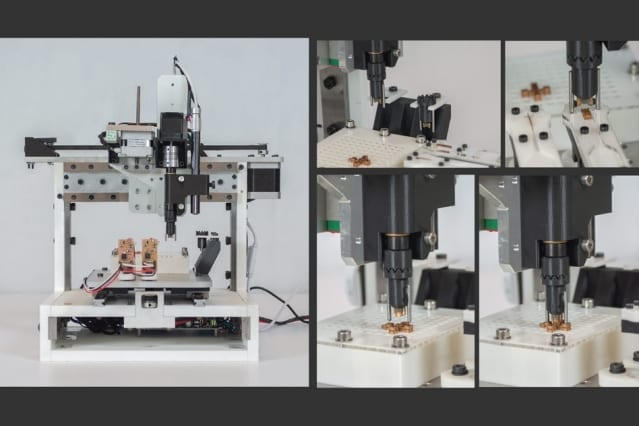
What does it take to fabricate electronic and medical devices tinier than a fraction of a human hair?
Nanoengineers at the University of California, San Diego recently invented a new method of lithography in which nanoscale robots swim over the surface of light-sensitive material to create complex surface patterns that form the sensors and electronics components on nanoscale devices. Their research, published recently in the journal Nature Communications,offers a simpler and more affordable alternative to the high cost and complexity of current state-of-the-art nanofabrication methods such as electron beam writing.
Led by distinguished nanoengineering professor and chair Joseph Wang, the team developed nanorobots, or nanomotors, that are chemically-powered, self-propelled and magnetically controlled. Their proof-of-concept study demonstrates the first nanorobot swimmers able to manipulate light for nanoscale surface patterning. The new strategy combines controlled movement with unique light-focusing or light-blocking abilities of nanoscale robots.
“All we need is these self-propelled nanorobots and UV light,” said Jinxing Li, a doctoral student at the Jacobs School of Engineering and first author. “They work together like minions, moving and writing and are easily controlled by a simple magnet.”
State-of-art lithography methods such as electron beam writing are used to define extremely precise surface patterns on substrates used in the manufacture of microelectronics and medical devices. These patterns form the functioning sensors and electronic components such as transistors and switches packed on today’s integrated circuits. In the mid-20thcentury the discovery that electronic circuits could be patterned on a small silicon chip, instead of assembling independent components into a much larger “discrete circuit,” revolutionized the electronics industry and set in motion device miniaturization on a scale previously unthinkable.
Today, as scientists invent devices and machines on the nanoscale, there is new interest in developing unconventional nanoscale manufacturing technologies for mass production.
Li was careful to point out that this nanomotor lithography method cannot completely replace the state-of-the-art resolution offered by an e-beam writer, for example. However, the technology provides a framework for autonomous writing of nanopatterns at a fraction of the cost and difficulty of these more complex systems, which is useful for mass production. Wang’s team also demonstrated that several nanorobots can work together to create parallel surface patterns, a task that e-beam writers cannot perform.
The Latest on: Nanofabrication
[google_news title=”” keyword=”nanofabrication” num_posts=”10″ blurb_length=”0″ show_thumb=”left”]
via Google News
The Latest on: Nanofabrication
- NSF director Panchanathan, U.S. Sen. Young tout value of university-private sector partnerships to grow national, economic securityon April 29, 2024 at 9:52 am
“Purdue has a special connection with the National Science Foundation: from multiple Boilermakers leading the NSF in recent decades to a broad range of major NSF centers led by Purdue faculty,” said ...
- Research combines DNA origami and photolithography to move one step closer to molecular computerson April 24, 2024 at 8:49 am
Molecular computer components could represent a new IT revolution and help us create cheaper, faster, smaller, and more powerful computers. Yet researchers struggle to find ways to assemble them more ...
- Optical memory of crystalson April 14, 2024 at 5:00 pm
Through a combination of physics-based simulations and hands-on experiments, both in her laboratory in DuPont Hall and at UD’s Nanofabrication Facility, Gu and her group are leaders in research on ...
- Nanofabrication Lab (IMAGE)on April 3, 2024 at 10:15 am
Disclaimer: AAAS and EurekAlert! are not responsible for the accuracy of news releases posted to EurekAlert! by contributing institutions or for the use of any information through the EurekAlert ...
- Top-down Nanotechnology and Its Role in Nanofabricationon February 25, 2024 at 3:58 am
Top-down nanotechnology represents a traditional approach to nanofabrication, contrasting with the atom-by-atom assembly characteristic of bottom-up methods. This technique involves starting with a ...
- Micro and Nanofabrication (MEMS)on January 22, 2023 at 6:21 am
Microfabrication and nanofabrication are the basis of manufacturing for nearly all modern miniaturized systems that are ubiquitously used in our daily life. Examples include; computer chips and ...
- Nanofabrication Labon August 17, 2020 at 9:11 pm
The Nanofabrication Lab features a state-of-the-art, 4,200 ft2 Class 100 clean room equipped with over 40 pieces of process and analytical instrumentation for complex research projects that require ...
- Core Research Facilitieson August 17, 2020 at 3:07 pm
Search our database to locate instruments and services in atomic layer deposition, material characterization, mechanical properties, nanofabrication, nuclear magnetic resonance (NMR), photo ...
- Clean Room & Nanofabrication Facilityon July 30, 2020 at 9:45 pm
The Integrated Sciences Cleanroom and Nanofabrication Facility has a 24-hour cancellation policy. Please notify the Manager at least 24 hours in advance if you can not honor your reservation. We ...
- What is nanofabrication?on October 22, 2018 at 7:59 am
The terms nanofabrication and nanomanufacturing are used to describe the creation of functional and complex nanoscale structures in various industries, including medical, photonics, electronics, and ...
via Bing News










